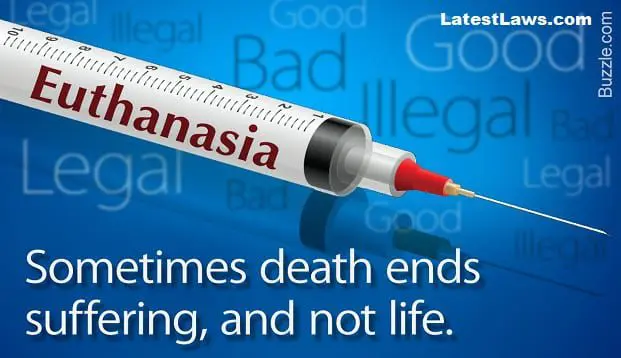
Trigger Warning: Mentions of suicide.
On the battlefield of Kurukshetra, Lord Bhishma laid down on the death bed of golden arrows, he asked Yudhishthira to offer him water to which Yudhisthira shot an arrow which pierced into the earth, digging out “The Ganges” as its drops moistened Bhishma’s lips, eventually embracing his own death through “Iccha Mrityu.”
Dan Diaz’s heartfelt heavier than ever when he had had his dying wife Brittany Maynard in his arms as she composedly died but most importantly happily. Dan had to stop his tears from rolling out of his eyes because of the promise he had made to his wife before undergoing Active Euthanasia in the state of Oregon, USA.
What connects these 2 events is – the act of killing oneself.
Definition
The word Euthanasia is a juxtaposition of 2 Greek words, ‘Eu’ means good, and ‘Thanatos’ means death.
Oxford English Dictionary defines euthanasia as, “the painless killing of a patient suffering from an incurable and painful disease or in an irreversible coma.”
Euthanasia has had many different meanings in all these years. Some called it “Mercy killing” while some referred to it as “death with dignity/pleasure.” In the modern world, euthanasia can be defined as the painless act of killing oneself to end pain and suffering. Another school of thought incorporates the word “suffering” into the definition.
Michael Wreen, a professor at Marquette University argued that the definition should also include compassion, to differentiate between euthanasia and serial killings.
Classification
Euthanasia can be broadly categorized into 5 different types –
Active Euthanasia
This happens when the doctors deliberately initiate an action or do something causing the patient to die. It may be injecting some lethal drugs else deliberate overdose of any medicines.
Passive Euthanasia
This happens when the doctors refrain themselves from doing something necessary or when they stop something that is keeping the patient alive. For example, switching off life support machines.
Voluntary Euthanasia
It occurs at the request of the concerned patient.
Non-Voluntary Euthanasia
It occurs when the patient is either mentally unstable or under age to take this decision as per the Law, so someone on their behalf takes the decision.
Involuntary Euthanasia
It occurs when the concerned patient does not give consent but undergoes euthanasia anyway.
Ethics of Euthanasia: India’s POV
Aruna Ramchandra Shaunbaug was an Indian nurse working at the King Edward Memorial Hospital, Mumbai. On November 27, 1973, Aruna was sexually assaulted by a ward boy in a changing room located in the basement of the Cardiovascular thoracic building of KEM Hospital after her shift had ended. Not only did he sexually abuse her but he also choked her with a dog chain.
She was admitted to the hospital but did not gain full consciousness… again, in her life. She remained in a vegetative state for 42 years till she died of Pneumonia on May 18, 2015.
On 17th December 2010, Pinky Virani a social activist-journalist who was also a friend of Aruna filed a petition in the Supreme Court arguing that the “continued existence of Aruna is in violation of her right to live in dignity.”
On March 7, 2011, the Supreme Court in a landmark judgment, legalized Passive Euthanasia in India. The SC also put out a set of guidelines viz, the decision to withdraw treatment or the decision to discontinue life support should be taken by parents, spouse, close relatives, and in the absence of them, a “next friend.” The decision also warrants court approval.
However, the SC rejected Virani’s plea to discontinue Aruna’s treatment because they chose the hospital staff and not Pinky Virani as Aruna’s “next friend” and the former did not support the idea of euthanizing Aruna.
Legal status outside India
Active Euthanasia is illegal in almost all countries while there has been a spurt of legalizing passive euthanasia. Those in favor say that in a civilized society, people should be able to choose when they are ready to die and should be helped if they are unable to end their lives on their own. But some critics take a moral stance against euthanasia and assisted suicide, saying life is given by God and only God can take it, says the BBC.
Others think that laws allowing euthanasia could be abused and people who do not want to die could be killed. The terminology around euthanasia is sometimes inconsistently applied, but there is a difference between euthanasia, assisted suicide, and assisted dying, says The Guardian.
That being said let us look at some of the countries where Euthanasia is legal –
- The Netherlands – This Dutch country became the first country to legalize euthanasia in 2002 April.
- Belgium – The Belgian parliament legalized euthanasia on May 2002.
- Luxembourg – Adults can undergo euthanasia in this country.
- Canada – Only adults suffering from “grievous and irremediable conditions” can opt for euthanasia in this country.
- Colombia – Terminally ill patients can request voluntary euthanasia in Colombia, and the first such death happened in 2015.
- Australia – This island legalized voluntary euthanasia in 2017.
- USA – Several US states like Oregon, Washington, Vermont, California, New Jersey, Colorado, Washington DC, Hawaii, Maine, and Montana have laws legalizing euthanasia.
The concept of euthanasia has opened up Pandora’s box of a raging debate in society. Marathi couple, Narayan Lavate and Iravati Lavate, both in their 80s appealed for active euthanasia by writing a letter to President Ram Nath Kovind. They demand their own euthanasia because they feel the country should not waste its already scarce resources on someone like them to keep them alive. Is their demand legal? Or is it too much to ask for? Does this demand go against human rights? Maybe yes or maybe not.

About the Author – Rajasik Mukherjee aka Raj is a sports freak but, wait, cricket doesn’t come in his favorites list. He hails from the land of Maa, Maati, Maanush. He is always in for Football discussions and puns and komedy.

Very well researched. Great job!
So much to take from here. Great one!
So well communicated; loved the Bhishm parallel and how it connects euthanasia to indian culture. This article compels one to think as well as leaves one questioning & reasoning about a very important topic that lacks public coverage.